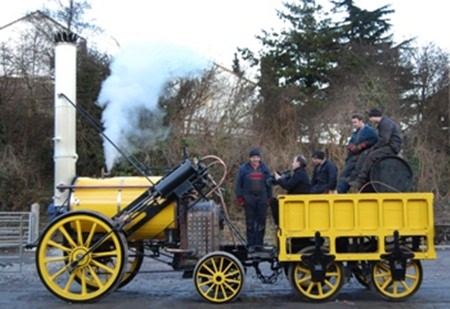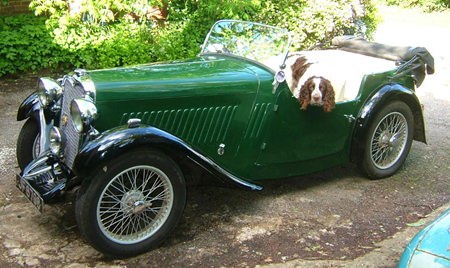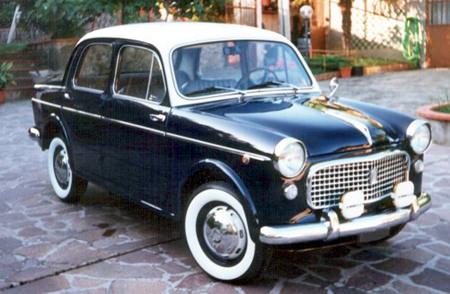George Stephenson was the brilliant designer whose steam engines once ruled the world.
On Sept. 27, 1825, railroad transportation was born when the first public passenger train, pulled by Stephenson’s Active (later renamed Locomotion), ran from Darlington to Stockton in the UK, carrying 450 passengers at 24 km per hour. Following the success Liverpool and Manchester interests called him in to build a 64 kilometer railroad line to connect the two cities. To survey and construct the line, Stephenson had to outwit the violent hostility of farmers and landlords who feared, among other things, that the railroad would supplant horse-drawn transportation and shut off the market for oats. (That reminds me of my grandmother who covered electric power points as she was sure the electricity would leak down the wall and discolor the wallpaper!)
 Stephenson’s Rocket.
Stephenson’s Rocket.
At the opening of the Liverpool-Manchester line in 1829, a competition was held for locomotives; Stephenson’s new engine, the Rocket, which he built with his son, Robert, won with a speed of 58 km per hour.
Whilst steam seemed the way to go for the railways, steam engines were not the only engines used in early automobiles. Between 1832 and 1839 (the exact year is uncertain), Robert Anderson of Scotland invented the first electric carriage.
These first electric cars used rechargeable batteries that powered a small electric motor. The vehicles were heavy, slow, expensive, and needed to stop for recharging frequently. Both steam and electric road vehicles were abandoned in favor of gas powered vehicles. Electricity found greater success in tramways and streetcars, where a constant supply of electricity was possible.
 Singer 9 Le Mans.
Singer 9 Le Mans.
And do not forget that Dr. Porsche built the first hybrid vehicles with electric in-wheel motors with a small petrol engine turning a dynamo to produce the necessary electricity for the batteries.
If we had only ventured further down the electric road, the world would not be controlled by the pimps at the pumps!
An “Auto” Biography
I’ve had a lot of cars. Even a quick count has the total over 100. However, as I have been besotted by cars all my life, this means there is a fair swathe of time that covers.
My first motoring memory was a wonderful BRG Singer 9 Le Mans sports car which my father bought post WW II. He said it was one of the three Singers entered at Le Mans, and even though it had huge headlights with stoneguards, it probably wasn’t one of the team cars. Dad was known to tell a few fibs, but I loved that car. I cried when it was sold.
 Five pound Fiat.
Five pound Fiat.
The next family car was a 1933 Morris Minor sedan. What a come-down from the racy Singer, but at least I was allowed to drive it on the deserted country roads of Scotland. The fact that the accelerator was in the middle, for some peculiar reason known only to William Morris (later Lord Nuffield), made driving the next car a problem till I got used to the normal position for the go pedal being on the right. The Morris was sold to the wreckers with a slipping clutch in 1953. I cried when that one went as well.
The first car I actually “owned” was a 1949 Austin A40 Devon. This model is distinguishable from the 1950 A40 Devon, in that it does not have quarterlights. I’m sure you will be on the lookout from now on. It does not really deserve to be remembered, other than the fact that I had to learn auto repairs to keep it running. My father bought me a Haynes manual, my automotive bible.
By this stage in my ‘auto’biography I had joined the MG Car Club (after beating an MG TF with the A40 in an unauthorized road race!) and I bought a BRG 1949 MG TC. I really was the starving medical student, working as a night watchman at the Red Cross Blood Bank and pumping petrol at the weekends and convinced a bank manager to give me a loan for “Textbooks”.
Having been seconded to a hospital in the Australian outback as a medical student, my next vehicle was a 1953 Ford V8 Customline. A lazy flat-head, side valve, huge lumbering beast that wallowed along the red dirt roads of western Queensland. It eventually disgraced itself by breaking a front stub axle and gently turned turtle on a suburban back street.
Buying another rather tatty Customline in 1964 for $50, I transferred all the good bits and traded it in for $175 on my next car, a black 1955 MGA, complete with a slipping clutch and a new one in a box on the passenger’s seat. Another Haynes manual later and the MGA now had a clutch and numbers on the doors with white shoe polish and my racing career began.
A working trip to the UK and Europe in 1966 saw my first Mk VII Jaguar in the garage, followed by another Mk VII M. Just like the Customlines, I cannibalized the two cars, kept the best one (VII M) and sold the tatty one.
After two years in the UK and Europe I received an offer I couldn’t refuse for the VII M Jaguar and then bought a Fiat 1100 to last me for the final three months of my stay in the UK before taking up a position as a ship’s surgeon for the voyage back to Australia. It cost five pounds, drank oil, produced a smokescreen that could bring out the fire brigade, but it lasted the 12 weeks. I parked it on Tilbury Docks in London and threw the keys in the water. (If it is still there, you can have it.)
On my return to Australia I bought a Mini 850 (sliding window variety) and a 1965 MGB roadster and an MGB fire damaged shell. Once again, cannibalizing the MGBs I built the first of the Super Bee series MGB race cars, which I drove for the British Leyland Works Team in Australia.
To tow the race car, a Chrysler Valiant ex-ambulance was purchased. What a great vehicle this was. All sorts of nooks and crannies to store tools, a stretcher to sleep on after we all took turns at driving the outfit the thousands of kilometers between home base Brisbane and race meetings in Sydney New South Wales. This had an added advantage that cars in front would see an ambulance bearing down on them and get out of the way, to be left perplexed as an ambulance with a trailer and a race car would rocket past!
When British Leyland pulled out of Australia, I was offered a very special one-off Mini Clubman GT 1275. What a wonderful pocket rocket that was! But oh, the quality, or lack of. Gearbox mountings, door handles, wipers, seat mounts etc etc etc all broke. After two years, Mini Clubman GT was traded in on the first of my Citroens, a new GS 1220 Club.
Thankfully it came with a warranty, as it was back at the dealership with no front brake pads after 3,000 km. The inboard discs were a swine to get at, and I only kept the GS for 12 months, replacing it with my first Japanese car. A friend sold Toyotas and I said I would buy one if it was faster than the Citroen, so a fully optioned Toyota Crown with air-conditioning that even had a crutch blower, in case the dangly bits got overheated, was next in the garage.
It was a lovely car to drive, but really too pedestrian for me, and as I had returned to racing cars, the Crown had to go. So what came next? I’m afraid you will have to wait for another day, as there are lots more to come!




